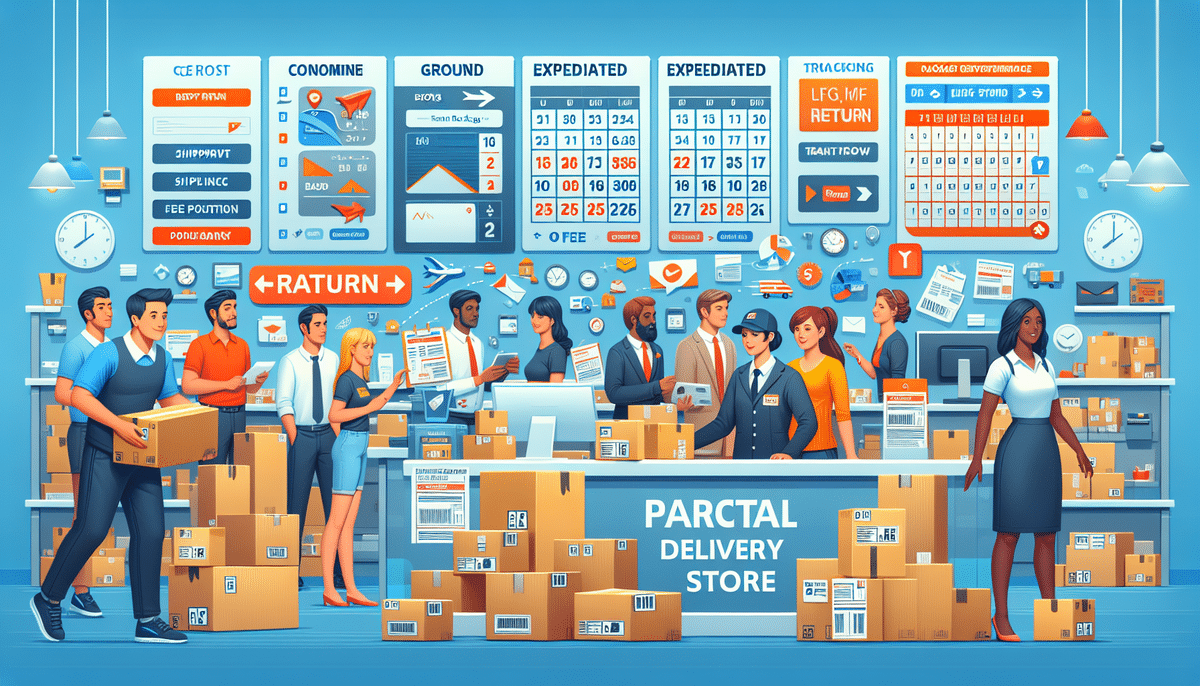Understanding UPS Returns: A Comprehensive Guide
As a consumer or business owner, it’s inevitable that at some point you may need to return a package. Whether it’s a product that didn’t meet your expectations or a gift that wasn’t quite right, returns are a common aspect of shipping. When it comes to returns, it’s important to understand your options and choose a shipping carrier that can handle the process smoothly and efficiently. This is where UPS Returns comes in.
Why Should You Use UPS for Returns?
UPS is one of the most trusted shipping carriers in the world, with a global network and decades of experience under their belt. When it comes to returns, UPS offers a variety of options that can help simplify the process. By using UPS for your returns, you can benefit from:
- Convenience: UPS offers a variety of return options, including scheduled pickup, drop-off at a UPS location, or printing a label and dropping the package off at a UPS access point.
- Flexibility: With UPS, you can choose the best option for your needs, whether it’s ground shipping for a cost-effective return or expedited shipping for a time-sensitive return.
- Reliability: UPS has a proven track record of delivering packages on time and in good condition, giving you peace of mind that your return will be handled with care.
- Cost-effectiveness: Using UPS for returns can also be cost-effective, as they offer competitive pricing and discounts for frequent shippers. Additionally, UPS offers a range of packaging options, including free boxes and envelopes, which can help you save money on shipping materials.
The Benefits of Using UPS Returns
In addition to the reasons why UPS is a good choice for returns, there are several benefits of using UPS Returns specifically. These include:
- Efficiency: By using UPS Returns, you can streamline the process and avoid any unnecessary delays or confusion that may arise when using another carrier.
- Transparency: With UPS Returns, you have access to real-time tracking and updates, so you can stay informed about the status of your return.
- Cost Savings: UPS offers competitive rates and flexible shipping options that can help you save money on your return.
- Convenience: UPS Returns offers multiple options for returning your package, including drop-off at a UPS location, scheduling a pickup, or using a UPS Access Point location. This flexibility allows you to choose the most convenient option for your schedule and location.
How to Initiate a UPS Return
To initiate a UPS return, there are several steps you’ll need to follow:
- Determine the type of return you need to make (e.g., product return, warranty return, etc.) and contact the business or retailer to obtain any necessary authorization or return documents.
- Choose the type of return shipping you prefer, such as scheduled pickup, drop-off at a UPS location, or printing a label and dropping off the package at a UPS access point.
- Create a UPS Returns label and affix it to your package.
- Attach any additional documentation required and securely package your return item(s).
- Hand the package to a UPS driver or drop it off at a UPS location/access point.
- Once your package has been received by UPS, you can track its progress using the tracking number provided on your label. You will receive updates on the package’s location and estimated delivery date.
Tips for Preparing Your Package for a UPS Return
To ensure that your return package arrives safely and in good condition, there are several best practices to follow:
- Use a sturdy box: Select a box that is durable enough to withstand the shipping process and won’t break or collapse under pressure.
- Secure all items: Make sure your return items are securely wrapped and packed, with adequate padding or cushioning to prevent damage during shipping.
- Seal the package: Use strong packing tape to ensure that the package is fully sealed and won’t come apart during transit.
- Label the package: Clearly label the package with the return address and the destination address, as well as any other relevant information such as the tracking number.
- Include a return slip: Be sure to include a return slip with your package, which should include your name, address, and order number. This will help the recipient identify your package and process your return more quickly and efficiently.
Understanding UPS Return Labels and Instructions
UPS Returns labels are unique and include specific information that must be followed in order to ensure a successful return. The label will include the sender’s and recipient’s addresses, as well as a barcode or tracking number. Make sure to follow all return instructions provided by the business or retailer, as these will help ensure that the return is processed correctly.
In addition to the information provided on the label, it is important to properly package the item being returned. This includes using appropriate packaging materials, such as bubble wrap or packing peanuts, to prevent damage during transit. It is also recommended to use a sturdy box that is the appropriate size for the item being returned.
Another important aspect of UPS returns is the timing of the return. Be sure to check the business or retailer’s return policy for any time restrictions or deadlines. It is also recommended to track the package using the provided tracking number to ensure that it has been received by the business or retailer. By following these guidelines, you can ensure a smooth and successful return process with UPS.
How to Track Your UPS Return Shipment
One of the benefits of using UPS Returns is the ability to track your package in real-time. You can use the tracking number provided on your label to access detailed tracking information on the UPS website or app. This will allow you to monitor the status of your return and receive updates on any delivery delays or other issues.
In addition, UPS also offers the option to receive text or email notifications for your return shipment. This means that you can receive updates on your package’s location and estimated delivery time without having to constantly check the tracking information online. To set up these notifications, simply enter your contact information and preferences on the UPS website or app when tracking your return shipment.
Common Issues and Solutions with UPS Returns
While UPS Returns is a reliable and efficient service, there are some common issues that may arise during the return process. These can include:
- Damaged packages
- Incorrect labeling
- Missed pickups
- Lost packages
If you encounter any of these issues, don’t hesitate to contact UPS customer service for assistance. They can help you resolve the problem and ensure that your return is processed correctly.
In addition to these common issues, it is important to note that UPS Returns may also have restrictions on certain types of items that can be returned. For example, hazardous materials or perishable goods may not be eligible for return through UPS. It is important to check with the retailer or shipper before initiating a return to ensure that your item is eligible for UPS Returns.
Another important consideration when using UPS Returns is the cost of shipping. While some retailers may offer free returns, others may require the customer to pay for return shipping. It is important to check the retailer’s return policy before initiating a return to avoid any unexpected costs. Additionally, UPS offers a variety of shipping options, including ground, air, and international, which may affect the cost and speed of your return shipment.
Using UPS Returns for E-commerce Businesses
For e-commerce businesses, UPS Returns can be an important part of the overall customer experience. By providing a simple and efficient return process, you can build trust with your customers and encourage repeat business. In addition, UPS Returns can help reduce the cost and hassle of managing returns in-house.
Furthermore, UPS Returns can also provide valuable data and insights into your customers’ purchasing behavior. By analyzing the reasons for returns, you can identify patterns and make improvements to your products or services. This can ultimately lead to increased customer satisfaction and loyalty.
Another benefit of using UPS Returns is the ability to offer flexible return options to your customers. With UPS Returns, you can provide your customers with the option to drop off their returns at a UPS location, schedule a pickup, or even print a return label from their own computer. This convenience can help improve the overall customer experience and make your business stand out from competitors.
International Returns with UPS: What You Need to Know
If you need to make an international return using UPS, there are some important things to keep in mind. First, you may need to provide additional documentation, such as customs forms or export declarations. In addition, shipping rates and transit times may vary depending on the destination country. UPS can help you navigate these requirements and ensure that your international return is processed correctly.
How to Handle Refunds and Exchanges with UPS Returns
Many businesses offer refunds or exchanges as part of their return policy. If you’re using UPS Returns for a refund or exchange, make sure to follow the guidelines provided by the business or retailer. UPS can help facilitate the return process, but the ultimate decision on refunds or exchanges rests with the original seller.
Best Practices for Managing Your UPS Returns Process
- Implement a clear return policy and communicate it effectively to your customers.
- Provide customers with easy access to return labels and instructions.
- Regularly review and optimize your return procedures to improve efficiency and customer satisfaction.
- Track return data to identify patterns and make data-driven decisions to enhance your products or services.
- Offer flexible return options to cater to your customers’ needs and preferences.
Cost Comparison: Is Using UPS for Returns Worth it?
When it comes to returns, the cost can be a major factor in deciding which carrier to use. While UPS may not always be the cheapest option, it does offer a variety of flexible shipping options that can help you save money in the long run. In addition, the reliability and convenience of UPS Returns may outweigh any additional cost considerations.
Case Studies: Successful Implementations of UPS Returns by Businesses
Many businesses have successfully implemented UPS Returns as part of their overall shipping strategy. By streamlining the return process and providing a positive customer experience, these businesses have been able to improve customer satisfaction and increase repeat business. Some examples of businesses that have successfully used UPS Returns include:
- Company A: Enhanced their customer experience by offering flexible and reliable return options, leading to a 20% increase in customer retention.
- Company B: Reduced their return processing time by 50% through the use of UPS Returns, resulting in improved operational efficiency.
- Company C: Leveraged return data insights to identify product issues and implement improvements, boosting customer satisfaction.
Conclusion
UPS Returns is a reliable and efficient way to handle returns for both consumers and businesses. By understanding the return process and using best practices to prepare your package, you can ensure that your return is processed quickly and accurately. Whether you’re making a product return or managing returns for your e-commerce business, UPS Returns can help simplify your shipping process and improve the overall customer experience.






















